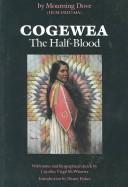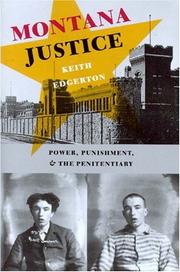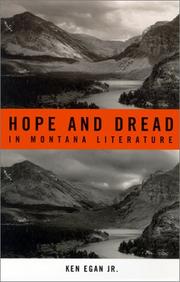| Listing 1 - 10 of 82 | << page >> |
Sort by
|
Periodical
Year: 1962 Publisher: Missoula, Bureau of Business and Economic Research, School of Business Administration, University of Montana.
Abstract | Keywords | Export | Availability | Bookmark
 Loading...
Loading...Choose an application
- Reference Manager
- EndNote
- RefWorks (Direct export to RefWorks)
Montana --- Montana. --- Economic conditions

ISBN: 0803284063 9780803284067 0803230699 9780803230699 0803281102 9780803281103 Year: 1981 Publisher: : Nebraska,
Abstract | Keywords | Export | Availability | Bookmark
 Loading...
Loading...Choose an application
- Reference Manager
- EndNote
- RefWorks (Direct export to RefWorks)
One of the first known novels by a Native American woman, Cogewea (1927) is the story of a half-blood girl caught between the worlds of Anglo ranchers and full-blood reservation Indians; between the craven and false-hearted easterner Alfred Densmore and James LaGrinder, a half-blood cowboy and the best rider on the Flathead; between book learning and the folk wisdom of her full-blood grandmother. The book combines authentic Indian lore with the circumstance and dialogue of a popular romance; in its language, it shows a self-taught writer attempting to come to terms with the rift between formal written style and the comfort-able rhythms and slang of familiar speech.
Book
ISBN: 1493002694 9781493002696 Year: 2013 Publisher: Guilford, Connecticut : Falcon Guides,
Abstract | Keywords | Export | Availability | Bookmark
 Loading...
Loading...Choose an application
- Reference Manager
- EndNote
- RefWorks (Direct export to RefWorks)
Hot springs --- Montana --- Wyoming
Book
ISBN: 1282130773 9786612130779 0803222777 0803213905 9780803222779 9780803213906 9781282130777 Year: 2009 Publisher: Lincoln : University of Nebraska Press,
Abstract | Keywords | Export | Availability | Bookmark
 Loading...
Loading...Choose an application
- Reference Manager
- EndNote
- RefWorks (Direct export to RefWorks)
This wide-ranging collection of essays addresses a diverse and expanded vision of Montana literature, offering new readings of both canonical and overlooked texts. Although a handful of Montana writers such as Richard Hugo, A. B. Guthrie Jr., D'Arcy McNickle, and James Welch have received considerable critical attention, sizable gaps remain in the analysis of the state's ever-growing and ever-evolving canon. The twelve essays in All Our Stories Are Here not only build on the exemplary, foundational work of other writers but also open further interpretative and critical conversations.
American literature --- Authors, American --- History and criticism. --- Homes and haunts --- Montana --- In literature. --- Intellectual life. --- American authors --- English literature --- State of Montana --- Монтана --- Щат Монтана --- Shtat Montana --- Μοντάνα --- Πολιτεία της Μοντάνα --- Politeia tēs Montana --- Montano --- Monekana --- Statul Montana --- Држава Монтана --- Država Montana --- Montana Eyaleti --- モンタナ --- モンタナ州 --- Montanashū --- Montana-shū --- Mont. --- MT --- Agrarians (Group of writers) --- Montana Territory
Book
ISBN: 1281958301 9786611958305 0803218710 9780803218710 9781281958303 080321751X 9780803217515 Year: 2008 Publisher: Lincoln : University of Nebraska Press,
Abstract | Keywords | Export | Availability | Bookmark
 Loading...
Loading...Choose an application
- Reference Manager
- EndNote
- RefWorks (Direct export to RefWorks)
It is hard to love the high, cold plains of the American West. They are vast and harsh and demanding. And perhaps because they are so hard to love, prairies challenge the imaginative mind and the adventurous heart. The Wide Open reveals how some of the most interesting and accomplished writers and photographers in the country have met that challenge and given the genius of the prairie a vision and a voice. Their stories are as diverse as the tellers, ranging from fiction by Barry Lopez, Richard Ford, and William Kittredge, to the childhood histories of Mary Clearman Blew and Judy Blunt and the
American literature --- Prairies --- Landscapes --- Countryside --- Landscape --- Natural scenery --- Scenery --- Scenic landscapes --- Nature --- Grasslands --- English literature --- Agrarians (Group of writers) --- Montana --- Država Montana --- Monekana --- Mont. --- Montana Eyaleti --- Montana-shū --- Montanashū --- Montano --- MT --- Politeia tēs Montana --- Shtat Montana --- State of Montana --- Statul Montana --- Πολιτεία της Μοντάνα --- Μοντάνα --- Щат Монтана --- Монтана --- Држава Монтана --- モンタナ --- モンタナ州 --- Montana Territory
Book
ISBN: 1280497874 9786613593108 0803237804 9780803237803 0803230117 9780803230118 Year: 2011 Publisher: Lincoln [Neb.] : University of Nebraska Press,
Abstract | Keywords | Export | Availability | Bookmark
 Loading...
Loading...Choose an application
- Reference Manager
- EndNote
- RefWorks (Direct export to RefWorks)
Mary Clearman Blew's education began at home, on a remote cattle ranch in Montana. She graduated to a one-room rural school, then escaped, via scholarship, to the University of Montana, where, still in her teens, she met and married her first husband. This Is Not the Ivy League is her account of what it was to be that girl, and then that woman -- pressured by husband and parents to be the conventional wife of the 1950s, persisting in her pursuit of an education, trailed by a reluctant husband and small children through graduate school, and finally entering the job market with a PhD in English only to find a whole new set of pressures and prejudices.
Blew, Mary Clearman, --- Clearman, Mary, --- Family. --- Montana
Book
ISBN: 0295802324 9780295802329 Year: 2006 Publisher: Seattle : University of Washington Press,
Abstract | Keywords | Export | Availability | Bookmark
 Loading...
Loading...Choose an application
- Reference Manager
- EndNote
- RefWorks (Direct export to RefWorks)
In On the Road Again, William Wyckoff explores Montana's changing physical and cultural landscape by pairing photographs taken by state highway engineers in the 1920s and 1930s with photographs taken at the same sites today. The older photographs, preserved in the archives of the Montana Historical Society, were intended to document the expenditure of federal highway funds. Because it is nearly impossible to photograph a road without also photographing the landscape through which that road passes, these images contain a wealth of information about the state's environment during the early decades of the twentieth century. To highlight landscape changes -- and continuities -- over more than eighty years, Wyckoff chose fifty-eight documented locations and traveled to each to photograph the exact same view. The pairs of old and new photos and accompanying interpretive essays presented here tell a vivid story of physical, cultural, and economic change. Wyckoff has grouped his selections to cover a fairly even mix of views from the eastern and western parts of the state, including a wide assortment of land use settings and rural and urban landscapes. The photo pairs are organized in thirteen "visual themes, " such as forested areas, open spaces, and sacred spaces, which parallel landscape change across the entire American West. A close, thoughtful look at these photographs reveals how crops, fences, trees, and houses shape the everyday landscape, both in the first quarter of the twentieth century and in the present. The photographs offer an intimate view into Montana, into how Montana has changed in the past eighty years and how it may continue to change in the twenty-first century. This is a book that will captivate readers who have, or hope to have, a tie to the Montana countryside, whether as resident or visitor. Regional and agricultural historians, geographers and geologists, and rural and urban planners will all find it fascinating.
Landscapes --- Natural history --- Montana --- Geography. --- Geography

ISBN: 0295800038 9780295800035 9780295984438 0295984430 Year: 2004 Publisher: Seattle : University of Washington Press,
Abstract | Keywords | Export | Availability | Bookmark
 Loading...
Loading...Choose an application
- Reference Manager
- EndNote
- RefWorks (Direct export to RefWorks)
Since the days of the wild West, Montanans have struggled to be "tough on crime" with limited resources. During Montana’s early territorial years, "criminal justice" was almost nonexistent: a few towns had inadequate and chronically overcrowded jails; occasional prisoners were sent east to the federal penitentiary in Detroit; and vigilantes summarily dealt with others suspected of crimes. In 1871, the federal government funded a penitentiary in Deer Lodge that was turned over to Montana when it achieved statehood in 1889. In this absorbing book, Keith Edgerton provides a social history of the Montana Penitentiary, with a primary focus on its early, formative years.After statehood, Montana leased its penitentiary to contractors, who utilized cheap inmate labor to turn a profit for themselves and for the state. Warden Frank Conley became a regional political boss and amassed a personal fortune, using inmates for road construction and a variety of public and private projects. Eventually, charges of corruption led to his ouster by Governor Joseph M. Dixon and sparked a trial and heated controversy that resulted in Dixon’s political downfall.After 1921 the prison system came under full control of the state government. Although there were changes at the penitentiary during the rest of the twentieth century--and two full-scale riots in the 1950s--there was also a depressing repetition of corruption, neglect, and underfunding.
Montana State Prison --- History. --- Finance --- Corrupt practices
Book
ISBN: 1496217268 9781496217264 9781496213358 1496213351 9781496217240 9781496217257 1496217241 Year: 2019 Publisher: Lincoln : University of Nebraska Press,
Abstract | Keywords | Export | Availability | Bookmark
 Loading...
Loading...Choose an application
- Reference Manager
- EndNote
- RefWorks (Direct export to RefWorks)
Foresters --- Arborists --- Police, Rural --- Koch, Elers, --- United States. --- FS --- Meiguo nong ye bu lin wu ju --- U.S. Forest Service --- USDA Forest Service --- USFS --- Officials and employees --- Foresters. --- Employees. --- Laborers --- Personnel --- Workers --- Persons --- Industrial relations --- Personnel management --- Montana. --- Država Montana --- Monekana --- Mont. --- Montana Eyaleti --- Montana-shū --- Montanashū --- Montano --- MT --- Politeia tēs Montana --- Shtat Montana --- State of Montana --- Statul Montana --- Πολιτεία της Μοντάνα --- Μοντάνα --- Щат Монтана --- Монтана --- Држава Монтана --- モンタナ --- モンタナ州 --- Montana Territory --- Montana-sh --- Montanash

ISBN: 0874175577 9780874175578 0874175089 9780874175080 Year: 2003 Publisher: Reno : University of Nevada Press,
Abstract | Keywords | Export | Availability | Bookmark
 Loading...
Loading...Choose an application
- Reference Manager
- EndNote
- RefWorks (Direct export to RefWorks)
"Egan's objective, in this survey of Montana's literary history, is to demonstrate the roots of the state's literature in its conflicted history and complex mixture of racial and ethnic traditions and, at the same time, to offer the possibility of thoughtful solutions to the West's daunting social and environmental dilemmas through the insights of some of the state's best writers. From the narratives of early explorers and ranchers, Native Americans, and settler women through the works of such major twentieth-century luminaries as A.B. Guthrie and Ivan Doig, Egan traces the evolution of Montanans' early fantastic dreams of economic, religious, and cultural success into failure and despair, violence and tragedy. Yet, side by side with these tales of woe are tales of endurance and even triumph, evidence of the strength and creative potential of the state's people."--Jacket.
Frontier and pioneer life in literature. --- Authors, American --- American literature --- American authors --- English literature --- Agrarians (Group of writers) --- Homes and haunts --- History and criticism. --- Montana --- Država Montana --- Monekana --- Mont. --- Montana Eyaleti --- Montana-shū --- Montanashū --- Montano --- MT --- Politeia tēs Montana --- Shtat Montana --- State of Montana --- Statul Montana --- Πολιτεία της Μοντάνα --- Μοντάνα --- Щат Монтана --- Монтана --- Држава Монтана --- モンタナ --- モンタナ州 --- Montana Territory --- In literature. --- Intellectual life.
| Listing 1 - 10 of 82 | << page >> |
Sort by
|

 Search
Search Feedback
Feedback About UniCat
About UniCat  Help
Help News
News